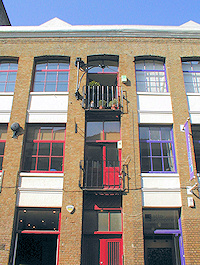Shoreditch
Shoreditch, Hackney/Tower Hamlets
A high-density, high-tech employment area situated north of Liverpool Street station

Shoreditch’s name is of Old English origin and refers to a dyke by a steep bank but the more fanciful explanation, espoused in Thomas Percy’s Reliques, is that Jane Shore, mistress of Edward IV, died in a ditch here in 1527.
Augustinian nuns founded a priory in Shoreditch in the twelfth century but significant development did not begin in the area until the 16th century, when building extended northward from Bishopsgate. Houses lined the High Street and a few more ran westwards on Old Street. The Theatre and the Curtain were the first successful London theatres when they were built west of the High Street in the fourth quarter of the 16th century.
The parish – and later the borough – of Shoreditch extended as far north as Hoxton and Haggerston; the vicinity of the medieval village is now sometimes called South Shoreditch to distinguish it from those outlying localities.
Shoreditch was one of the first ‘outer London’ districts to fuse with the City and the parish had around 10,000 inhabitants by 1750, together with 15 almshouses and St Leonard’s church.

Within a hundred years the population had increased tenfold, with many residents working in local industries – especially the furniture, upholstery and timber trades. Philanthropists and the borough and county councils replaced slum housing with blocks of flats but the area remained overcrowded until after the Second World War.
Central Shoreditch is still crammed with Victorian warehouses and industrial buildings, contrasting starkly with the marble and glass of the neighbouring City of London. The printing, engineering, furniture and clothing industries maintain a presence here but in the early 1990s Shoreditch became popular with a wide spectrum of the arts and media communities, ranging from sculptors to website designers. The trend stuttered as a result of rising rents – and perhaps an excess of hype – but the phenomenon is far from dead.
Shoreditch House is a private members’ club and art-house cinema on Ebor Street, Shoreditch Town Hall has been restored as a cultural and leisure destination and XOYO is a hip nightclub and live music venue on Cowper Street.
The southernmost tip of the district, beyond Worship Street, has the greatest concentration of office blocks, merging geographically and architecturally with the City.
Shoreditch Tw*t was a 2002 Channel 4 television production based on the content of a long-running fanzine (which did not use an asterisk) that lampooned the lifestyle of local media trendies.
Malcolm Needs’ unsuccessful 2003 film Shoreditch unravelled the mystery of a corpse found in the cellar of a derelict jazz club.
